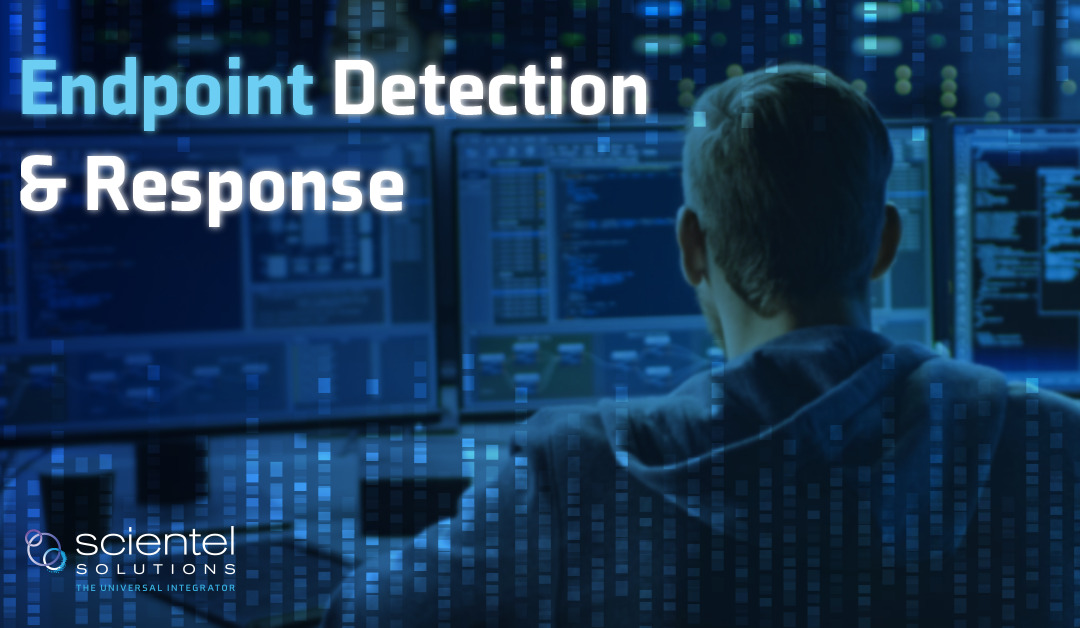by Bryce Verhaeghe, Network Operations Engineer III
Untested software in IoT devices, cloud solutions galore, a plethora of bring-your-own devices lurking in the network, and poor or non-existent security policies have created a new edge, and it’s sharp on both sides. Mix in a little poor judgment from you and yours, and you’ve left your network open for attack. Endpoint Detection and Response (EDR) is the software organizations can use to get visibility into threats at the endpoint. EDR solutions represent a variety of approaches to keep nefarious elements out of systems. These solutions are often paired with other security solutions and are part of a larger, layered security plan and policy for any organization, which should be thoroughly considered.
Endpoint Detection and Response Defined
EDR solutions protect networks by providing awareness of threats at the endpoints through logging collection, network analysis, vulnerability scanning, threat signature analysis and identification, telemetry, and new network detection. EDR solutions aggregate data from multiple points, provide a streamlined perspective of events, and can offer incident management to help mitigate network threats from nefarious actors or the occasional error in judgment. Additionally, EDR solutions can offer Security Information and Event Services (SIEM). Managed security platforms can help aggregate EDR data from numerous locations, assist with alerts to Security Operations Centers (SOC), notify emergency personnel, and provide higher-level visibility into an organization’s risk factors. In short, EDR solutions monitor data collection on end-user devices and deliver a holistic approach to collecting and correlating information and events across a multitude of hosts in a network (Karantzas & Patsakis, 2021). EDR capabilities are designed to detect, contain, investigate, and eliminate threats (Cisco Systems, Inc, 2022). Others take further steps and discover, predict, prevent, detect, defuse, respond, investigate, and remediate or rollback (Fortinet Training Institute, 2021, p. 12)
Why EDR?
For modern networks, security assistance is necessary. Attack surfaces have grown in every direction but inward. The shortage of security staff is rampant, network complexity has considerably increased, and operational risk is ever-changing. Dedicating human resources for every security need is impossible, but employing EDR solutions help streamline, prioritize, and automate security processes. These solutions can shut down infected endpoints and recognize known and unknown threat signatures. They can even take preventive action through preconfigured response rules. Organizations need EDR solutions to protect against known threats, evasive malware, zero-day attacks, fileless attacks, targeted attacks, insider threats, and ransomware (Palo Alto Networks, 2022).
Weighted Considerations
EDR solutions are typically not integrated into core network elements. They also do not replace antivirus tools but rather work alongside them. Exposure is an important consideration. For instance, the human component necessitates EDR in an organization’s networks but Managed Security Services might not have a return on investment if an organization does not utilize cloud services, only has one location, or users don’t typically work remotely. IT managers should be mindful of the multitude of marketing languages associated with EDR as they investigate solutions. Each vendor offers variants of the features discussed here. Likewise, consider the features presented after an attack, in real-time, and which prevent attacks. When searching for EDR solutions, adding the following keywords to search strings will lead to comprehensive research for solutions that fit the needs of an organization:
EDR – Endpoint Detection and Response (Sometimes known as Endpoint Threat Detection and Response or ETDR)
EPP – Endpoint Protection Platforms
XDR- Extended Detection and Response
MSP – Managed Services Platform
SOC – Security Operations Center
Security Fabric
Scientel Solutions is a long-time managed services provider. Our experts have decades of experience managing and securing networks. Scientel Solutions has established relationships with numerous EDR vendors and can assist organizations in evaluating needs and implementing solutions that fit.
References:
Cisco Systems, Inc. (2022). What is EDR? – Endpoint detection and response. Retrieved from https://www.cisco.com/c/en/us/products/security/endpoint-security/what-is-endpoint-detection-response-edr-medr.html#~edr-capabilities
Fortinet Training Institute. (2021). Proactive Advanced Endpoint Protection, Visibility, and Control for Critical Assets. Fortinet.
Karantzas, G., & Patsakis, C. (2021, July 9). An empirical assessment of endpoint detection and response systems against advanced persistent threats attack vectors. Retrieved from https://www.mdpi.com/2624-800X/1/3/21/htm
Palo Alto Networks. (2022). What is endpoint detection and response (EDR)? Retrieved from https://www.paloaltonetworks.com/cyberpedia/what-is-endpoint-detection-and-response-edr

